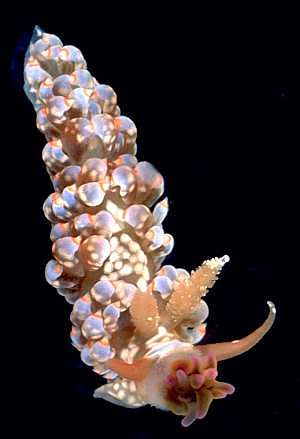
Spurilla australis
Rudman, 1982
Order: NUDIBRANCHIA
Suborder: AEOLIDINA
Family: Aeolidiidae
DISTRIBUTION
Probably found throughout Australia with records from South Australia, Western Australia, Queensland and New South Wales. Also found in northern New Zealand.
PHOTO
Upper Right: Dark colour form with half-swallowed sea anemone Cricophorus nutrix, in its mouth. Split Solitary Is, Coffs Harbour, NSW, February 1987.
Lower Right: Light colour form, Pilot Beach, Laurieton, NSW, November 1979.
Lower Left: Head of Spurilla australis showing the network of brown ducts (ringed) in which the zooxanthellae are "farmed". Pilot Beach, Laurieton, NSW, November 1979.
PHOTOS: Bill Rudman.
RELATED TOPIC
Spurilla australis is a member of the aeolid family Aeolidiidae, whose members all feed on sea anemones and related cnidarians. Its particular food is a small brown sea anemone Cricophorus nutrix which is usually found living attached to subtidal brown algae. Consequently, Spurilla australis is normally found crawling on or amongst brown algae. Sea anemones usually attach themselves firmly to a rock or other firm object with sticky secretions and the muscular actions of their "pedal disc" and are usually very hard to dislodge. Cricophorus nutrix however has evolved an escape behaviour. When disturbed it rapidly releases its hold and drops off the algae. This is a useful way of escaping from the attack of crawling predators such as nudibranchs. On a number of occasions I have watched Spurilla australis feeding on Cricophorus and it seems to have found a way of beating the anemone. As it approaches and "feels" the anemone with its long oral tentacles, it lines itself up with a tentacle on each side of the anemone then wraps the tentacles around the anemone so that as the anemone loosens its hold on the algae it is prevented from falling off. Spurilla then pulls the anemone to its mouth and engulfs it.
Some aeolidiids, including Spurilla australis and Berghia verrucicornis, feed on sea anemones which have single-celled plants (zooxanthellae) living in their bodies. This "living together" or symbiosis is quite common in cnidarians, the most well-known example being the reef-corals which could not produce their massive reefs without the assistance of the plants that grow in their tissues. When the aeolids eat the sea anemones they store the still living plants in special ducts connected to their digestive systems, where they are kept alive and "milked" of the sugars they produce when they photosynthesise. In the photo alongside of the head of Spurilla australis, the brown network pattern behind the head tentacles (rhinophores) are a network of ducts in the skin which contain brown zooxanthellae. This brown network penetrates the skin of all parts of the body which are open to sunlight. In this way the zooxanthellae are "farmed" in the best parts of the body for plant growth. For some reason some animals either lose their zooxanthellae or never retain any. Animals without any plants are very pale in colour, as in the animal on the right in the top photo.
Reference:
• Rudman, W.B. (1982) The taxonomy and biology of further aeolidacean and arminacean nudibranch molluscs with symbiotic zooxanthellae. Zoological Journal of the Linnean Society, 74: 147-196.
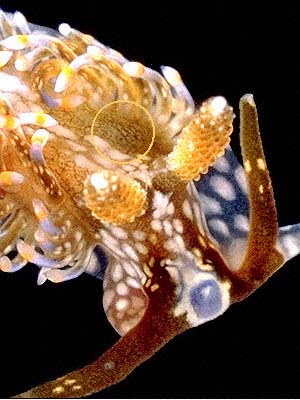
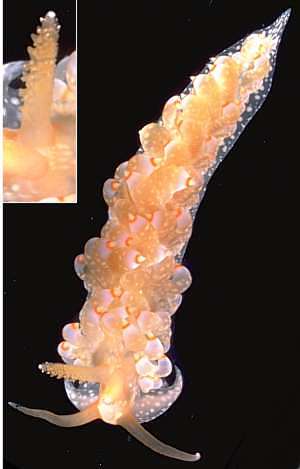
Rudman, W.B., 1999 (July 21) Spurilla australis Rudman, 1982. [In] Sea Slug Forum. Australian Museum, Sydney. Available from http://www.seaslugforum.net/find/spuraust
Related messages
Re: Anemone capture by Spurilla major
October 14, 2008
From: David Mullins
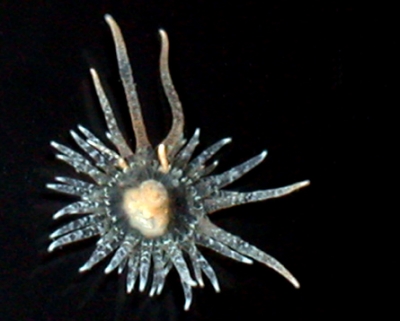
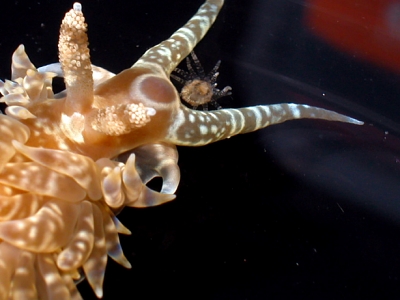
Concerning message #126:
Dear Bill,
Here are some photos of what we are calling Baeolidia major Eliot, 1903. Other synonyms are Spurilla major (Eliot, 1903) and Berghia major (Eliot, 1903). I guess I'll leave the latest definitive name to you guys.
Anyway, the pics illustrate the behaviour you made mention of on this forum as having observed with Spurilla australis. In this particular case the prey was not on an algal frond and could not drop away, however the base of the black photographic dish is very smooth affording little purchase for the 'pedal disc'. The long oral tentacles of the nudibranch however are certainly being put to the same use as you described in enveloping the prey.
Recently here at Woody Point I have observed up to 5 at a time of this species within an area of one metre square moving through the algae in strong tidal currents in the search for their anemone prey.
Locality: Woody Point, Redcliffe Peninsula, Moreton Bay, intertidal, Queensland, Australia., Pacific Ocean, 20 August 2008, Intertidal weed, rocky substrate. Length: 75 mm. Photographer: David Mullins.
Kind regards,
David Mullins
marineimages@hotmail.com
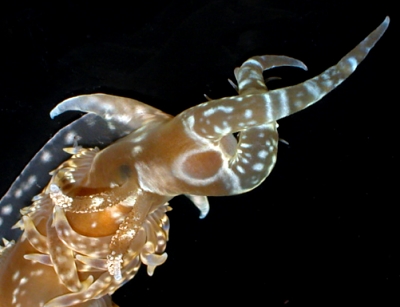
Dear David,
Thanks for these photos and the observations on its feeding behaviour. This seems to be a standard behaviour for some of these larger aeolids which eat sea anemones whole. It's good to get another observation.
Concerning the other names you mention for this species - they just demonstrate a lack of agreement in the genera of the Aeolidiidae. Some years ago when I was studying solar-powered aeolids and their close relatives, it became clear that in the soft-coral feeding species of Phyllodesmium, many of the anatomical differences resulted from adaptations they had evolved to 'farm' zooxanthellae in their bodies. In those times there were almost as many generic names used for species of Phyllodesmium as there were species (Rudman, 1981). Within the Aeolidiidae the genera Berghia, Baeolidia and Spurilla were very poorly defined and in a similar nomenclatural-taxomic mess. Some species had symbiotic zooxanthellae and branches of the digestive gland ramifying through all parts of the body wall and others did not, and yet all anatomists who have previously worked on these animals had ignored this fundamental fact. The only difference consistently argued was that the rhinophores were lamellate in Spurilla and papillate in Berghia. The question of Baeolidia was - and remains - even more confused because it was based on a single preserved specimen from the western Indian ocean which is unidentifiable. I proposed we use Spurilla for them all until the group was properly revised (Rudman, 1982), and I am sure the continued confusion will continue until they are properly revised. Since we can't define Baeolidia its use seems indefensible. I suspect a revision will suggest we need more than just Spurilla but until then the apparently random use of Spurilla, Berghia and Baeolidia is very confusing.
-
Rudman, W. B. (1981) The anatomy and biology of alcyonarian feeding aeolid opisthobranch molluscs and their development of symbiosis with zooxanthellae. Zoological Journal of the Linnean Society, 72: 219-262.
-
Rudman, W. B. (1982) The taxonomy and biology of further aeolidacean and arminacean nudibranch molluscs with symbiotic zooxanthellae. Zoological Journal of the Linnean Society, 74: 147-196.
Best wishes,
Bill Rudman
Spurilla australis from Port Stephens
October 8, 2007
From: Leanne & David Atkinson
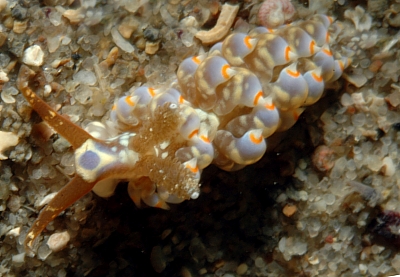
Hi Bill,
We found this tiny nudibranch in amongst some brown algae. We moved it out onto the sand to get some clearer shots. It's not one we've seen before in our diving at Port Stephens. Is it Spurilla australis? It looks similar to the ones on the site and you mentioned that they are usually found near brown algae. The rings on the end of the cerata seem to vary a bit amongst the specimens photographed. Can you help us identify it? You don't have one from Port Stephens on the site so this may add to your range information.
Locality: The Pipeline, Nelson Bay, Port Stephens, 8 metres, New South Wales, Australia, Pacific, 01 October 2007, Silty, sandy bottom with scattered sponges, soft corals, kelp, ascidians and gorgonias. Length: 5 mm. Photographer: Leanne & David Atkinson.
We were worried after the big storms and floods of June that the Port Stephens area may take some time to recover, however there seems to be plenty of nudibranchs around now.
Regards,
Leanne & David Atkinson
atk@hunterlink.net.au
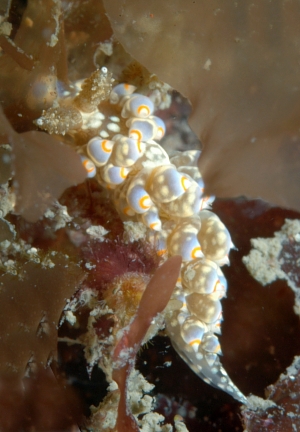
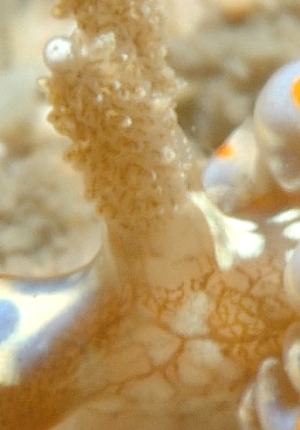
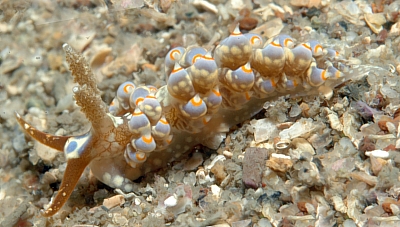
Dear Leanne & David,
Yes this is Spurilla australis. This is a solar-powered species which 'farms' dark brown zooxanthellae in its body, and the greater the population of its zooxanthellae, the darker is the colour of its body. The zooxanthellae are stored in specialised branches of the digstive gland which form a network of tubes throughout the body wall and skin, as well as the cerata. The middle right photo is a close-up showing the network of branching ducts in the skin of the left rhinophore and the side of the head.
I am glad to hear the influx of freshwater from the June rains only had short-term affects on the marine environment. Unfortunately, the lack of follow-up rains, which has been a blessing for the marine fauna, has at the same time been a disaster for the farming communities of eastern Australia.
Best wishes,
Bill Rudman
Spurilla australis from Lembeh Straits, Sulawesi
March 26, 2007
From: Matt Oldfield
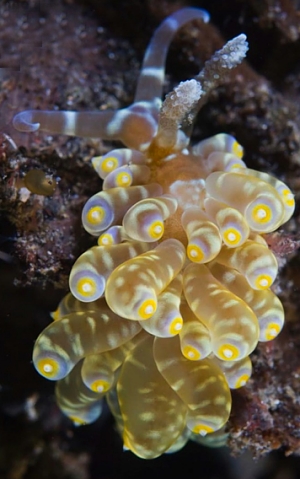
I shot this nudi in the Lembeh Straits, Sulawesi, late last year and it is being used in a book which is going to press very soon. However I cannot identify it at all, and am wondering if anyone can help me out. Image attached, and many thanks.
Locality: Lembeh Straits, 10 m aprox. Sulawesi, Pacific, December 2006, Black sand bottom. Length: 2 cms aprox. Photographer: Matt Oldfield.
Matt Oldfield
matt@scubazoo.com
Oldfield, M., 2007 (Mar 26) Spurilla australis from Lembeh Straits, Sulawesi. [Message in] Sea Slug Forum. Australian Museum, Sydney. Available from http://www.seaslugforum.net/find/19744Dear Matt,
This is almost certainly Spurilla australis but I am beginning to wonder if S. australis is just a form of the much less colourful Spurilla major. I guess if you are about to publish the name in a book, you should stick to S. australis at this stage.
Best wishes,
Bill Rudman
Spurilla australis from Western
January 19, 2007
From: Bruce Potter
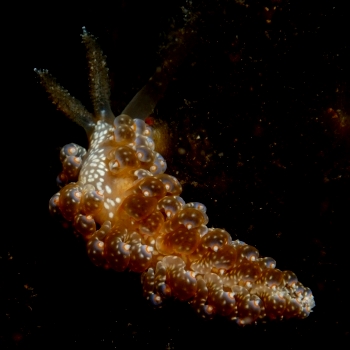
Dear Bill,
I recently dived under the Busselton Jetty in Western Australia, and on a night dive I found this very pretty nudibranch which I have not been able to identify in any of my books.
Locality: Busselton, 6 metres, Western Australia, Indian Ocean, 7 January 2007, under a jetty. Length: 25mm. Photographer: Bruce Potter.
It was about 25mm long.
Regards
Bruce Potter
bandppotter@bigpond.com
Potter, B., 2007 (Jan 19) Spurilla australis from Western . [Message in] Sea Slug Forum. Australian Museum, Sydney. Available from http://www.seaslugforum.net/find/19242Dear Bruce,
This is Spurilla australis. It appears to be solar powered with a pale form when it lacks zooxanthellae and a dark form like this when it has a population growing inside. It is often found on brown algae where it hunts down and eats small brown sea anemones.
Best wishes,
Bill Rudman
Spurilla australis from Victoria, Australia
August 22, 2006
From: Trevor McMurrich
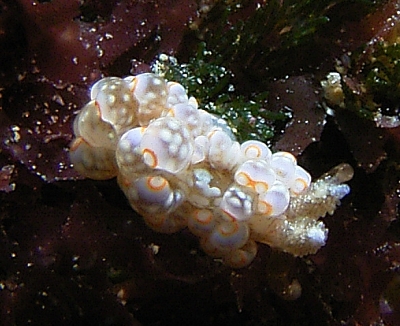
Hi Bill,
Can you please help me with identification of this nudibranch?
Locality: Popes Eye, Port Phillip Bay, 2 metres, Victoria, Australia, 12 August 2006, man made rocky reef. Length: 15 mm. Photographer: Trevor McMurrich.
Thank you,
Trevor
trevm@aanet.com.au
McMurrich, T.B., 2006 (Aug 22) Spurilla australis from Victoria, Australia. [Message in] Sea Slug Forum. Australian Museum, Sydney. Available from http://www.seaslugforum.net/find/17453Dear Trevor,
This is Spurilla australis. It must the time for them in Port Phillip Bay. See message #16890.
Best wishes,
Bill Rudman
Spurilla australis from Port Phillip Bay, Australia
June 22, 2006
From: Perry Davis
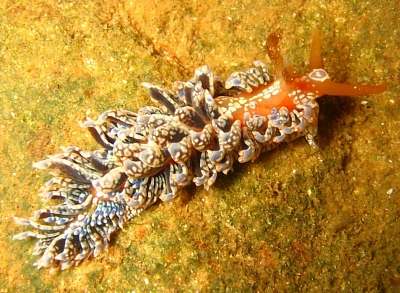
Dear Bill,
I found this nudibranch at low tide in very shallow water on flattend seagrass in Swan Bay, Victoria on the15 june 2006. It was a cloudy day and this 30 mm creature was active. Hope you can identify it for me!
Locality: seagrass beds, 200ml, Swan Bay, Bellarine Peninsula, Port Philip Bay, Victoria. Australia, tidal bay, 15 June 2006, intertidal seagrass bed. Length: 30mm. Photographer: Perry A Davis.
Regards
Perry Davis
perryadavis@bigpond.com
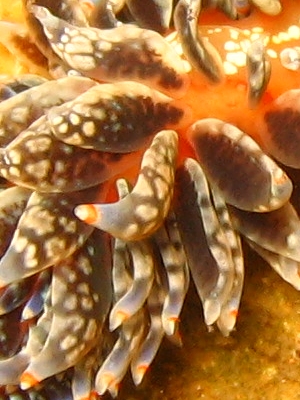
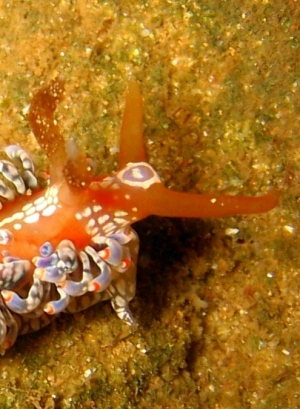
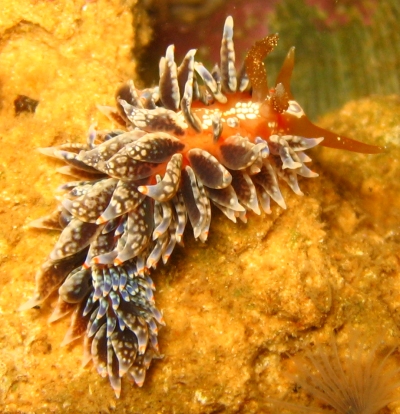
Dear Perry,
This is Spurilla australis which we often think of as a warm-water, if not tropical, Australian species, but it seems to be found all around mainland Australia. Have a look at the species Fact Sheet for information on the biology of this fascinatingsolar-powered nudibranch. It is able to grow single-celled plants in its digestive system and take advantage of their ability to photosynthesise sunlight into sugars.
In your photos you can see how this solar-powered species has modified its body to assist its 'horticultural' activities. Firstly, its cerata, which are usually cylindrical in aeolids, have become flattened and leaf-like, to provide more sunlit surfaces for the captive plants. You will also see a dark brown network inside the cerata. This network is the highly branched digestive gland, in which the plants [zooxanthellae] are nurtured. Most aeolids have just a single duct in each ceras, but in these solar-powered animals, every extra branch provides an extra place for more plants.
Best wishes,
Bill Rudman
Spurilla australis from Northern New South Wales
February 2, 2005
From: Denis Riek

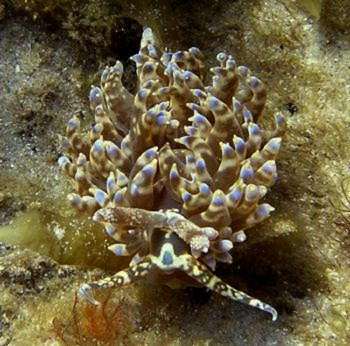
Dear Bill,
Thanks for your reply on Spurilla major. I observed several examples of Spurilla australis this winter and all looked like the animal in the upper photo, all around 25-30mm. The larger animal (65mm) in the other photos is what I wrongly believed to be Spurilla major. At least I was correct when I said that I had seen Spurilla major in the river, I just didn't know what I was looking at. The variations in colour and pattern in some species makes it hard for us amateurs, Bill.
Locality: Brunswick River, nthn N.S.W. Australia. Depth: 3 metres. Length: 65 mm. 25 August 2004. on algae covered rocks on sea wall. Photographer: Denis Riek
Regards,
Denis
denisriek@hotmail.com
Riek, D.W., 2005 (Feb 2) Spurilla australis from Northern New South Wales. [Message in] Sea Slug Forum. Australian Museum, Sydney. Available from http://www.seaslugforum.net/find/12923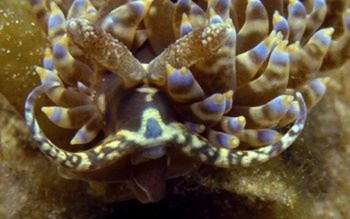
Dear Denis,
There's no shame in getting an identification wrong - I do it all the time. I think they deliberately make it difficult for us. The colour difference in this case is quite an interesting story, some of which is on the Fact Sheet. This is one of the species I have called solar-powered, because they can get much of their energy requirements from 'farming' microscopic plants in their tissues. The light coloured form ,in your upper photo, is an animal in which the plant population in its body is very sparse, while the dark brown version is an animal with many healthy plants [zooxanthellae].
Best wishes,
Bill Rudman
Spurilla australis from Western Australia
February 20, 2004
From: Mark Gerlach
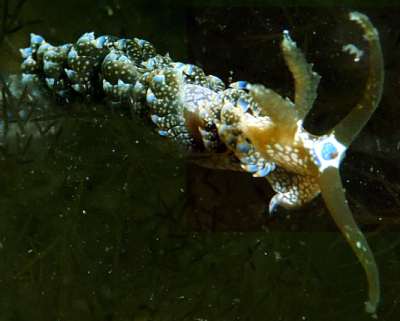
Hi Bill,
I photographed this seaslug in the Swan River, near Rocky Bay, [Perth Western Australia]. Is it Spurilla australis? It looks darker then pictures I have seen.
Depth was about 3m
Sandy bottom with brown seaweed.
Slug lengh 20mm.
Cheers,
Mark.
silverthorne@bigpond.com
Gerlach, M., 2004 (Feb 20) Spurilla australis from Western Australia. [Message in] Sea Slug Forum. Australian Museum, Sydney. Available from http://www.seaslugforum.net/find/12250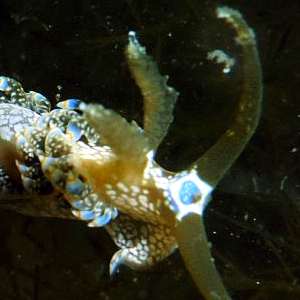
Dear Mark,
Yes this is Spurilla australis. Much of the brown colouration comes from the zooxanthellae in their bodies which I discuss in the species Fact Sheet. The darker brown the zooxathellae, and the greater their concnetration, the darker the background colour of the slug
Best wishes
Bill Rudman
Spurilla australis from Perth, Western Australia
October 18, 2003
From: Masoud Abadi
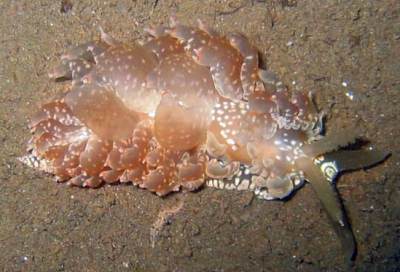
Hi
I have some new pics that may be of interest..
This one is from a Swan River [Perth, Western Australia] night dive, 14 October 2003.
Masoud Abadi
masoud@theinternetmen.com
Abadi, M., 2003 (Oct 18) Spurilla australis from Perth, Western Australia. [Message in] Sea Slug Forum. Australian Museum, Sydney. Available from http://www.seaslugforum.net/find/11270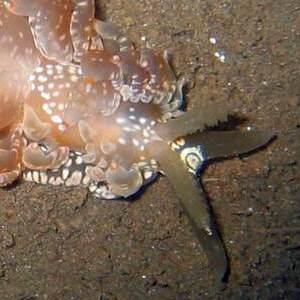
Thanks Masoud,
This is indeed of interest. It is a pale form of Spurilla australis. You can see the orange ring near the tip of each flattened cerata, and the papillae on the rhinophores. There are only one or two records of this species being found in Wetern Australia so this is a valuable addition
Best wishes
Bill Rudman
Nudibranch on Caulerpa taxifolia
August 18, 2003
From: Tim Glasby
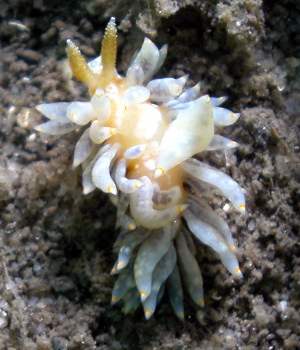
Dear Bill,
To accompany my message on Elysia on Caulerpa taxifolia, here is a photo of another nudibranch found on C. taxifolia in Botany Bay (Sydney, Australia) at a depth of 3 m. Do you happen to recognise it?
All the best,
Tim Glasby
tim.glasby@fisheries.nsw.gov.au
Glasby, T., 2003 (Aug 18) Nudibranch on Caulerpa taxifolia. [Message in] Sea Slug Forum. Australian Museum, Sydney. Available from http://www.seaslugforum.net/find/10774Dear Tim,
This is the aeolid Spurilla australis . It feeds on sea anemones. I have found it feeding on the little brown anemone Cricophorus nutrix. It is interesting because it is one of a group of nudibranchs which have evolved a symbiotic relationship with zooxanthellae [see Solar powered Sea Slugs Pages], but I'm afraid I can't think of any way it could help with the Caulerpa problem.
Best wishes,
Bill Rudman
Aeolidiopsis australis?
August 6, 2002
From: Nishina Masayoshi
Dear Bill,
I found a name Aeolidiopsis australis Rudman, 1982; Gosliner, 1985. Is this a valid species? If so, do you have any photo or illustration of this animal?
Best Regards,
Nishina Masayoshi
nishina@wips.co.jp
Dear Nishina,
I described a new species Spurilla australis in 1982. In 1985, Terry Gosliner considered it was more appropriately placed in the genus Berghia, a genus which I had considered to be a synonym of Spurilla. In a recent review, Michael Miller (2001) considers it should belong in the genus Baeolidia. So in its reasonably short life, this species has been called Spurilla australis, Berghia australis and now Baeolidia australis. This is part of the on-going debate that occurs as we try and understand the evolutionary history and relationships of animals. In most cases, names are very stable, but in others cases, such as the Aeolidiidae, I suspect the debate has still a way to go.
• Gosliner, T.M. (1985) The aeolid nudibranch family Aeolidiidae (Gastropoda: Opisthobranchia) from tropical southern Africa. Annals of the South African Museum, 95(6): 233-267.
• Miller, M.C. (2001) Aeolid nudibranchs (gastropoda: Opisthobranchia) of the family Aeolidiidae from New Zealand waters. Journal of Natural History, 35: 629-662.
Best wishes,
Bill Rudman
Spurilla australis from Victoria
January 9, 1999
From: Jane Breidahl
I am a very keen 'pier diver' and was very excited to find my first Spurilla australis under Portsea pier two days ago. It was in about 6 metres of water and was amongst a brown seaweed. I was actually looking for sea hares which are mating at the moment. I dive with a very keen (and talented) photographer - Glenys Greenwood. Neither of us had seen this species here before, though we have found Spurilla macleayi on rare occasions. We always 'hit the books' when we come home from a dive and with Bob Burn always keen to help us and a good microscope for accurate identification, we usually do pretty well. I wonder if the distinctly pulsating white area that we observed behind the rhinophores is the ducts that you refer to in your june message?. It seemed as though there was something like a heartbeat going on here. I thoroughly enjoyed reading your page and will look at it again.
regards,
Jane Breidahl
deepsea@alphalink.com.au
Breidahl, J., 1999 (Jan 9) Spurilla australis from Victoria. [Message in] Sea Slug Forum. Australian Museum, Sydney. Available from http://www.seaslugforum.net/find/455Dear Jane,
Good to get a record from Port Phillip Bay, Victoria. Any other sea slug observations from Victoria would be welcome. If Glenys has any photographs she would like to share with the world I would be happy to put them on the Slug Forum.
The pulsating white lump you mention is indeed the heart. The fine ducts can really only be seen easily if they contain brown zooxanthellae. They form a network all over the body in areas which are exposed to sunlight.
Best wishes,
Spurilla australis
July 2, 1998
From: Bill Rudman


PHOTOS: Upper: Head of Spurilla australis showing the network of brown ducts (ringed) in which the zooxanthellae are "farmed". Pilot Beach, Laurieton, NSW, November 1979. Lower: Head of dark colour form with half-swallowed sea anemone Cricophorus nutrix, in its mouth. Split Solitary Is, Coffs Harbour, NSW, February 1987. Photos: Bill Rudman
In response to Michael Phan's question on Berghia verrucicornis, here is some information on a closely related Australasian species. Spurilla australis is a member of the aeolid family Aeolidiidae, whose members all feed on sea anemones and related cnidarians. Its particular food is a small brown sea anemone Cricophorus nutrix which is usually found living attached to subtidal brown algae. Consequently, Spurilla australis is normally found crawling on or amongst brown algae. Sea anemones usually attach themselves firmly to a rock or other firm object with sticky secretions and the muscular actions of their "pedal disc" and are usually very hard to dislodge. Cricophorus nutrix however has evolved an escape behaviour. When disturbed it rapidly releases its hold and drops off the algae. This is a useful way of escaping from the attack of crawling predators such as nudibranchs. On a number of occasions I have watched Spurilla australis feeding on Cricophorus and it seems to have found a way of beating the anemone. As it approaches and "feels" the anemone with its long oral tentacles, it lines itself up with a tentacle on each side of the anemone then wraps the tentacles around the anemone so that as the anemone loosens its hold on the algae it is prevented from falling off. Spurilla then pulls the anemone to its mouth and engulfs it.
Some aeolidiids, including Spurilla australis and Berghia verrucicornis, feed on sea anemones which have single-celled plants (zooxanthellae) living in their bodies. This "living together" or symbiosis is quite common in cnidarians, the most well-known example being the reef-corals which could not produce their massive reefs without the assistance of the plants that grow in their tissues. When the aeolids eat the sea anemones they store the still living plants in special ducts connected to their digestive systems, where they are kept alive and "milked" of the sugars they produce when they photosynthesise. In the photo alongside of the head of Spurilla australis, the brown network pattern behind the head tentacles (rhinophores) are a network of ducts in the skin which contain brown zooxanthellae. This brown network penetrates the skin of all parts of the body which are open to sunlight. In this way the zooxanthellae are "farmed" in the best parts of the body for plant growth. For some reason some animals either lose their zooxanthellae or never retain any. Animals without any plants are very pale in colour, as in the animal on the right in the top photo.
Bill Rudman
